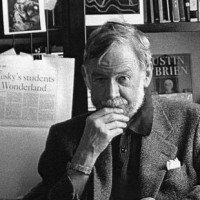
RMIT University, officially the Royal Melbourne Institute of Technology (RMIT), is a public research university in Melbourne, Australia.

Queen Victoria Village, generally known as QV Melbourne or just QV, is a precinct in the Melbourne central business district, Victoria, Australia. Covering the city block bounded by Lonsdale, Little Lonsdale, Swanston, and Russell Streets, and located directly opposite the State Library of Victoria and Melbourne Central, QV comprises a large shopping centre, a central plaza, an underground food court, Melbourne central city's first full-size supermarket and apartment buildings.

The Capitol is an historic theatre on Swanston Street in the central business district (CBD) of Melbourne, Victoria, Australia. Opened in 1924 as part of the Capitol House building, the art deco theatre was designed by American husband and wife architects Walter Burley and Marion Mahony Griffin, and is the oldest of Melbourne's large picture palaces. It is famous for its extravagant decor and abstract motifs, including an intricate geometric ceiling containing thousands of coloured lamps, designed to evoke the walls of a crystalline cave.

Dr Norman Kingwell Day is an architect, educator, and writer.
Philip J. Goad is an Australian academic, currently serving as Professor of Architecture in the Faculty of Architecture, Building and Planning at the University of Melbourne. He is also a former President of the Victorian Chapter of the Royal Australian Institute of Architects. Phillip became Chair of the Heritage Council of Victoria in July 2021.

Edmond and Corrigan is an Australian architectural firm based in Melbourne, Victoria, founded in the late 1970s by partners Maggie Edmond and Peter Corrigan, the firm's principals. The practice's work, both built and written, has been widely associated with the emergence of architectural postmodernism in Australia, an interest in suburbia and a search for an Australian architectural identity. Peter Corrigan taught design studios at RMIT University for over 30 years, until his death in December 2016.

Peter Russell Corrigan was an Australian architect and was involved in the completion of works in stage and set design.

RMIT University Library consists of six academic branch libraries in Australia and Vietnam. Its four Australian branches are located on the RMIT University campuses in Melbourne City, Bundoora and Brunswick; and its two Vietnamese branches are located at the RMIT University Vietnam campuses in Ho Chi Minh City and Hanoi.

Daryl Sanders Jackson AO is an Australian architect and the owner of an international architecture firm, Jackson Architecture. Jackson also became the associate professor of the University of Melbourne and Deakin University.
The Melbourne City campus of the Royal Melbourne Institute of Technology is located in the city centre of Melbourne in Victoria, Australia. It is sometimes referred to as "RMIT City" and the "RMIT Quarter" of the city in the media.

Storey Hall, located at 342–344 Swanston Street in Melbourne, Australia, is part of the RMIT City campus of the Royal Melbourne Institute of Technology. It consists of a grand meeting hall constructed in 1887, extended and renovated in 1996, providing a large upper hall, the lower hall as home to RMIT Gallery First Site, and a range of lecture theatres and seminar rooms.
Margaret Leonie Edmond is an Australian architect.
Wood Marsh Architecture, styled Wood | Marsh Architecture, is a Melbourne-based Australian architectural practice founded by Roger Wood and Randal Marsh in 1983.

Cassandra Fahey is an Australian architect and interior designer residing in Melbourne, Australia. She is Director of the architecture firm "Cassandra Complex". She emerged in the public spotlight in 2000 because of the controversial 'Newman House', located in St Kilda, designed for media and football identity Sam Newman. She is also known for her works on "The Smith Great Aussie Home" and the BHP Billiton Healesville Sanctuary "Platypusary". Her work has received a number of awards as well as being featured in many local and international publications.

The Athan House was designed by the Melbourne-based architectural firm of Edmond and Corrigan and is located in Monbulk, a town located in the Dandenong Ranges just outside metropolitan Melbourne, Australia. The project team consisted of Peter Corrigan, Adrian Page and Chris Wood. The house was designed and constructed between 1986-88.

The Ringwood Library: Edmond and Corrigan is situated in the Eastern suburbs of Melbourne, Victoria, within the Ringwood Plaza complex. completed in 1995 The building stands alone as an icon in the area of Ringwood and sets itself apart from the surrounding plaza and is noticeably differentiates from eastland shopping centre, which sits to the north of the site.

Niagara Galleries shows contemporary and Modernist Australian art in Richmond, an inner suburb of Melbourne, from a terrace which has been substantially remodelled in a postmodern style.

The RMIT Design Hub is a design hub that houses research, archive, exhibition and studio space of the Royal Melbourne Institute of Technology in Melbourne, Australia.

The Swanston Academic building is an RMIT building designed by the architecture firm Lyons and is located on Swanston Street in Melbourne across from Peter Corrigan designed building 8 and ARM's Storey Hall. Construction began in September 2010 and was completed in September 2012. The budget for the SAB was $200,000,000. The new building contains 35,000 square metres (380,000 sq ft) of floor space, is 11 storeys high and provides 6 large lecture theatres for students. The colourful building is intended to reflect the cities surroundings in the façade. “The idea is to wear the ‘cloak’ of the city”.

The Argus Centre is a postmodernist highrise office building situated on the corner of La Trobe Street and Elizabeth Street, Melbourne. It was designed by architect Nonda Katsalidis whilst he was a director of AXIA Pty Ltd for client Ryssal Three. The project team consisted of Nonda Katsalidis, Gerard Van Beer, Geoff Cosier, Ric Wood, Philip O’Dwyer, Shmuel Dolev, Leon Moulton and John Iappazutto. The building was constructed between 1991 and 1993 with a contract value of AUS $64 million. The current value of the building is $173.9 million.




















